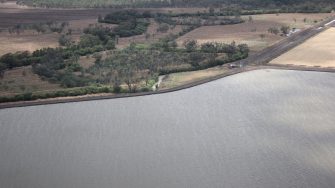
Date: Monday, November 14, 2016
Project: Eastern Australian Waterbird Survey
Observer: Richard Kingsford
The next few days will be the last of the survey for the year. I will be glad to be out of the plane, even though it has been a great privilege to see the rivers. It’s tiring work. We set off from Sydney over the Great Dividing Range for Moree into a 30knot southwesterly, which made surveying the rest of the day unpleasant as the plane was buffeted around.
Flying over the Great Dividing Range between Sydney and Moree
Today we concentrated on the Gwydir River wetlands, west of Moree. They are represented by those in the south, along the Mehi River and Mallowa Creek and in the north by the Gwydir and the Gingham watercourse. First, we flew west along the Mehi and Mallowa Creek, surveying the waterholes. With little overbank flooding, there were no more than about 100 waterbirds along this part of the system.
Surveying waterholes along the Mehi River and Mallowa Creek
As well as large government-built dams and weirs upstream, the flows in this river system are now also affected by the diversion of water to privately built storages or dams on the floodplain, allowing water to be diverted mainly for cotton irrigation.
Off river storage on the Mehi River
With less flooding, agricultural crops have become increasingly established on the Gwydir floodplain and its different creeks and rivers.
Cropping on the Gwydir floodplain
There are other signs of stress for the floodplain, including floodplain trees in poor condition with their sparse canopies. This is usually a result of not receiving enough water with the frequency required, primarily because it is now diverted for irrigated agriculture.
Dead and dying floodplain trees
Once we had surveyed the southern part of this river system, we worked our way from west to east along the more diverse and interesting Gingham watercourse, which had recently received environmental flows. Relatively little had reached the end of the system. Unlike most of the other rivers we have surveyed over the last month and a half, the Gwydir has missed out on the extensive flooding we have seen elsewhere.
Near the end of the Gingham system
Despite the proximity of agricultural crops established on wetland areas, the Gwydir River wetlands still have many of their original values, albeit considerably reduced in size and diversity. It was immediately obvious from the vivid green of the reedbeds that we were in a productive wetlands. This was reinforced by the black ducks lined up along the channels in their hundreds, with scattered flocks of egrets and ibis scattered throughout the wetland.
Gwydir River wetlands
Scattered lagoons among the reedbeds of the Gwydir wetlands
We threaded our way along the sometimes narrow waterways, hemmed in by agricultural crops, to find some of the more expansive areas of wetland with their waterbirds. There was even a flock of about 50 magpie geese which are increasingly common in the Murray-Darling wetlands, a real cause for hope.
Surveying along the Gingham watercourse on the Gwydir River system
Flooding creeks are essential for the productive Gwydir wetlands
A flock of waterbirds on the Gwydir wetlands
We completed the survey along the Gwydir River, where the river is regulated by Yarraman Weir, near Moree. This is one of the structures with Copeton Dam and large privately built storages which regulates the flows in the Gwydir River, diverting water for irrigation that once reached the wetlands.
Yarraman Weir on the Gwydir River
